alto flute
All scores that include a part for at least one alto flute.
Snow Pond Anthology—2015
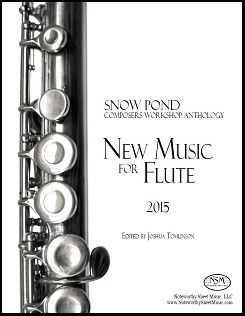 Snow Pond Composers Workshop Anthology New Music for Flute 2015
Snow Pond Composers Workshop Anthology New Music for Flute 2015
Edited by Joshua Tomlinson, PDF $21.95
The first annual Snow Pond Composers Workshop took place June 7-13, 2015, under the direction of Edward Jacobs and Richard Nelson. The workshop was part of the broader Snow Pond Music Festival taking place in Sidney, Maine. Peter H. Bloom was the Visiting Performing Artist, and Elliott Schwartz was the Guest Composer. The Snow Pond Composers Workshop Anthology—New Music for Flute 2015, edited by Joshua Tomlinson, includes all of the scores presented at the workshop:
ED by Sean O. G. Burns | one player, on flute with kick drum and voice
Where Wind Blows by William C. Edwards | solo flute
Farewell to Charms by Henry Feinberg | solo flute
Amuse-Bouche by Edward Jacobs | solo flute
Published by American Composers Alliance, reprinted with permission.
Stillness by Richard Nelson | trumpet, saxophone, guitar, bass, and drums/percussion;
or, flute and electric guitar (or other small combination of instruments)
Party On, Bloom! by Alan Racadag | one player, on piccolo, C-flute, alto flute,
and optional bass flute
Soliloquy III by Elliott Schwartz | one player, on flute, piccolo, alto flute, and piano
Published by American Composers Alliance, reprinted with permission.
Something Human by Joshua Tomlinson | solo flute
Indecision (...or maybe not) by Isaac Ward | solo flute
Vyvirian Folk Songs by Julian Ward | solo flute
Quicksilver by Joshua Zinn | solo flute
This is a remarkable collection of new music for flute, which Noteworthy Sheet Music is pleased to make available to the broader flute community. Our edition includes composer biographies and performance notes, as well as the scores.
Here's a YouTube link to a 9/23/2023 performance of ED by Peter H. Bloom:
Preview
Awarded 2018: Congratulations to composer Edward Jacobs on being awarded a prestigious Guggenheim Foundation Fellowship.
Tchaikovsky - Arab Dance - Alto Flute & Harp/Piano
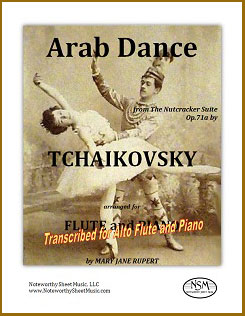 Arab Dance, by P. Tchaikovsky
Arab Dance, by P. Tchaikovsky
Arranged for Flute and Harp or Piano by Mary Jane Rupert
Transcribed for Alto Flute by C.A.Vater
Alto Flute Part and Harp or Piano Score, PDF $7.99
Mary Jane Rupert's arrangement of The Nutcracker for flute and harp or piano includes all of the pieces from the original Suite, Op. 71a, except the Overture. Dr. Rupert stayed as close as possible to the original orchestration, in terms of key, harmony, register, and color. Originally published in 1988, the arrangement was re-edited by Dr. Rupert in 2013 for publication as separate flute/piano and flute/harp editions by Noteworthy Sheet Music. After creating the new flute editions, Noteworthy Sheet Music's editors realized that one of the pieces of the suite in particular, Arab Dance, would work beautifully on alto flute. We created an alto flute transcription of the flute part, both for ourselves and for our alto flutist friends.
We offer separate versions of the score for piano or harp, although in the case of the Arab Dance the harp-specific notation is minimal compared to some of the other pieces contained in the complete edition of The Nutcracker arranged for flute and harp.
 Alto Flute & Harp Edition: Harp score, 6 pages; Alto Flute part, 1 page; Total, 10 pages. $7.99
Alto Flute & Harp Edition: Harp score, 6 pages; Alto Flute part, 1 page; Total, 10 pages. $7.99Preview
 Alto Flute & Piano Edition: Piano score, 6 pages; Alto Flute part, 1 page; Total, 10 pages. $7.99
Alto Flute & Piano Edition: Piano score, 6 pages; Alto Flute part, 1 page; Total, 10 pages. $7.99
Preview
Vercoe - Butterfly Effects - Flute(s) and Harp
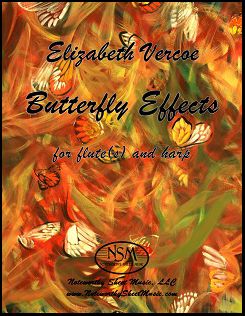 Butterfly Effects, by Elizabeth Vercoe
Butterfly Effects, by Elizabeth Vercoe
Contemporary Composition for Flute(s) and Harp
Flute Part and Harp Score, PDF $26.99
Butterfly Effects is an intriguing and varied piece in seven sections for flute and harp in which the flutist is asked to play bass, alto, piccolo and concert flutes. The titles are the names of butterflies: Mourningcloak, Banded Blue Pierrot, Common Jezebel, Question Mark, Monkey Puzzle, Karner Blues, and Psyche.
Excerpted from Elizabeth Vercoe's preface: "Butterfly Effects for flute and harp was written for the duo "2", with flutist Peter H. Bloom and harpist Mary Jane Rupert, who premiered the first parts of the piece in Bangkok and the entire work in Illinois in 2010. Along with the butterflies themselves, a quotation from Zhuangzi was the starting point for the music: "Am I a human who dreamt of being a butterfly or am I now a butterfly who dreams of being human?" The Taoist philosopher's dream illustrates, among other lessons, his sense of oneness with all living beings. // All seven movements are short, some only a minute in length. Mourningcloak, for alto flute and harp, is somber and reflective. Banded Blue Pierrot (concert flute) is short and glittering. Common Jezebel is a sultry tango for bass flute and harp that becomes increasingly chromatic and contrapuntal, requiring the harpist to do some fancy footwork. Question Mark, also for bass flute, requires the flutist to use "beat boxing" and key slap techniques that maximize the percussive qualities of the flute. Monkey Puzzle, in a kind of mimicry of the confusing antennae and pseudo antennae of the insect, flutters along to the middle of the piece and then proceeds backwards to the beginning in what is known as retrograde motion. Karner Blues adopts some of the riffs of blues instrumentalists and singers in the only movement for piccolo. Psyche, a word meaning breath or soul in Greek, is for concert flute and reminds us again of the Zhuangzi dream and the oneness of all living beings."
Butterfly Effects may be performed by one flutist playing multiple instruments, or by multiple flutists each playing one instrument for the relevant movement(s).
Our striking cover image for this publication is of the painting "Jezebel Tapestry #2" by Louisa King Fraser, used with the artist's permission.
Butterfly Effects for flute(s) and harp received a rave review by Nicole Riner in the Fall 2015 edition of the National Flute Association’s membership magazine The Flutist Quarterly. Read the review in its entirety reprinted on the NSM website with permission from the NFA, or visit the NFA website.
Peter H. Bloom gave a lecture on “Effective Writing for Flutes and the Contemporary Flutist” at the 2018 Snow Pond Composers Workshop. In his presentation, Mr. Bloom discussed various topics using four contemporary works published by Noteworthy Sheet Music, including Butterfly Effects, as examples. We later published a free text version of this excellent presentation on our website, in the Reviews and Articles section, including some of the audio clips and supplemental written materials that Mr. Bloom used as demonstrations.
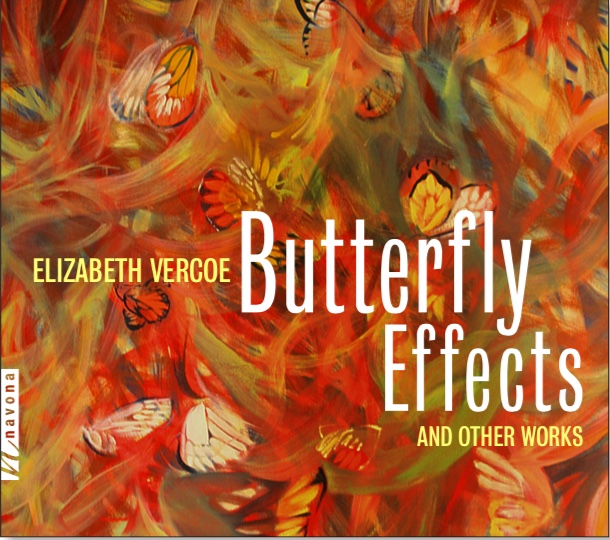 The Elizabeth Vercoe CD "Butterfly Effects and Other Works" was released in November 2018. The CD is available through Navona Records and features the title track performed by duo "2". Here is a quote from Cinemusical's review of the CD: "The album opens with a multi-movement work for flutes and harp, Butterfly Effects (2009). Across the seven movements, Vercoe explores the qualities of different instruments in the flute family: alto flute, bass flute, concert flute, and piccolo. The music has a slight impressionistic quality to it, aided by the harp’s material. Against this is first a rather dreamy, dark opening movement (“Mourningcloak”); a faster-paced flitting “Banded Blue Parrot”; a tango (“Common Jezebel”); intriguing effects like beat-boxing (“Question Mark”) and blues riffs (“Karner Blues”); and a palindromic compositional technique (“Monkey Puzzle”). The flute lines allow for registral exploration and often features some sinuous lines. Some are sultrier than others, but it is as if these are all like watercolor brushstrokes that tend to be somewhat introspective in this often stunningly beautiful work." Another nice review of this CD, written by Nicole Riner, came out in the Flutist Quarterly Spring 2019 edition; here's a quote: "I had the pleasure of reviewing the sheet music for Butterfly Effects for this publication in 2015 and found it to be wonderfully diverse and intriguing. /// Bloom and Rupert perform this work deftly and with a great sense of unity”.
The Elizabeth Vercoe CD "Butterfly Effects and Other Works" was released in November 2018. The CD is available through Navona Records and features the title track performed by duo "2". Here is a quote from Cinemusical's review of the CD: "The album opens with a multi-movement work for flutes and harp, Butterfly Effects (2009). Across the seven movements, Vercoe explores the qualities of different instruments in the flute family: alto flute, bass flute, concert flute, and piccolo. The music has a slight impressionistic quality to it, aided by the harp’s material. Against this is first a rather dreamy, dark opening movement (“Mourningcloak”); a faster-paced flitting “Banded Blue Parrot”; a tango (“Common Jezebel”); intriguing effects like beat-boxing (“Question Mark”) and blues riffs (“Karner Blues”); and a palindromic compositional technique (“Monkey Puzzle”). The flute lines allow for registral exploration and often features some sinuous lines. Some are sultrier than others, but it is as if these are all like watercolor brushstrokes that tend to be somewhat introspective in this often stunningly beautiful work." Another nice review of this CD, written by Nicole Riner, came out in the Flutist Quarterly Spring 2019 edition; here's a quote: "I had the pleasure of reviewing the sheet music for Butterfly Effects for this publication in 2015 and found it to be wonderfully diverse and intriguing. /// Bloom and Rupert perform this work deftly and with a great sense of unity”.
Flute part, 16 pages; Harp Score, 43 pages; Total, 66 pages.
PreviewWeber - Grand Duo Concertant - Alto Flute
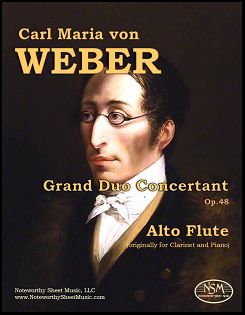 Grand Duo Concertant, Op.48, by Carl Maria von Weber
Grand Duo Concertant, Op.48, by Carl Maria von Weber
Transcribed for Alto Flute (and Piano) by John W. Pratt
Alto Flute Part, PDF $9.98
Carl Maria von Weber (1786-1826), an important forerunner of the Romantic school, was a prolific composer, yet wrote only three substantial chamber works. One is the Grand Duo Concertant for clarinet (or violin) and piano. Sounding a bit like Mozart on steroids, with robust harmonies and brilliant passagework, it has three movements - an exciting Allegro con fuoco, a beautiful Andante with a very rich, chordal piano accompaniment and passionate piano interlude, and a sparkling Rondo. We offer this excellent alto flute transcription of the clarinet part; the piano part is readily available in the public domain, as a free high quality pdf download of the score for clarinet and piano; here is a link to the listing on imslp.org: Piano Score
Alto Flute part, 10 pages; Total, 12 pages.
Preview